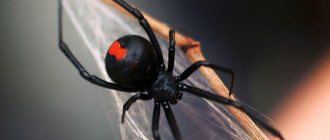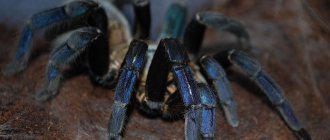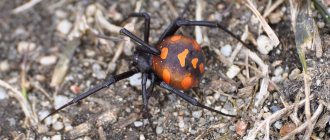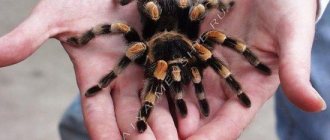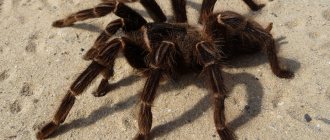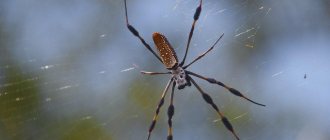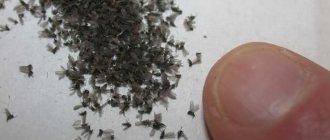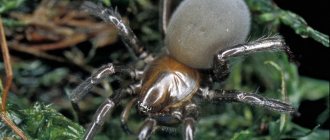If you look at the Guinness Book of Records and see who is the largest spider in the world, then you will see Theraphosa blondi. This type of spider has other common names, namely “tarantula spider” and “goliath tarantula spider”.
This spider was first described in 1804 by the French entomologist Pierre Andre Latreille.
Theraphoza Blonda is of great interest to collectors, but due to the export ban, as well as the fact that it requires seasonal changes in its conditions of detention, it is quite difficult to get such a specimen into the collection.
Description of the Goliath tarantula
The largest mygalomorphic spider, Theraphosa blondi, belongs to the large family Theraphosidae (from the suborder Orthognatha), which includes approximately 800 species.
The term “tarantula spiders” appeared thanks to Maria Sibylla Merian, a German animal painter who depicted the attack of a huge spider on a hummingbird in a series of her engravings. Her work "Metamorphosis insectorum Surinamensium" with drawings of an arachnid monster was presented to the public in 1705, but only a century later (in 1804) Theraphosa blondi received a scientific description from the French entomologist Pierre André Latreille.
Appearance
Like other spiders, the body of the goliath tarantula consists of two sections connected by a special tube - the cephalothorax and a complete abdomen. About 20–30% of the volume of the cephalothorax is in the brain. The dorsal shield of the Goliath spider has equal width and length.
The cephalothorax is divided by a groove into two parts, the head and chest, the first being equipped with 2 pairs of limbs. These are chelicerae, consisting of a single thickened segment with a movable claw (under the tip of which there is a hole for removing poison) and a pedipalp, divided into 6 segments.
The mouth, adapted for sucking out soft contents, is located at the top of the tubercle between the chelicerae. Four pairs of legs, each of which is composed of 7 segments, are attached directly to the cephalothorax, behind the pedipalps. The goliath tarantula is discreetly colored, in different shades of brown or gray, but light stripes are noticeable on the legs, separating one segment from the other.
Interesting. Theraphosa blondi is shaggy - long hairs cover not only the limbs, but also the abdomen, the stinging hairs of which are used for protection. The spider scratches them with its hind leg towards the enemy.
The hairs act like tear gas, causing itching, stinging in the eyes, swelling and general weakness. Small animals (rodents) often die, large ones retreat. In humans, hairs can cause allergies, as well as blurred vision if they get into the eyes.
In addition, the hairs, which detect the smallest vibrations in the air/soil, replace the spider (deprived of ears from birth) with the organs of hearing, touch and taste. The spider does not know how to recognize taste with its mouth - the sensitive hairs on its legs “report” on the edibility of the victim. Hairs also become a useful material when weaving webs in a nest.
Goliath spider dimensions
It is believed that an adult male grows up to 4–8.5 cm (excluding limbs), and a female – up to 7–10.4 cm. Chelicerae grow on average to 1.5–2 cm. The leg span in rare cases reaches 30 cm, but more often does not exceed 15–20 cm. Record figures for dimensions belong to females of Theraphosa blondi, whose weight often reaches 150–170 g. It was this specimen with a paw span of 28 cm, caught in Venezuela (1965) that was included in the Guinness Book of Records.
Lifestyle, behavior
Each goliath tarantula has a personal area, the area of which is several meters from the shelter. Spiders do not like to leave the lair far and long, so they try to hunt nearby in order to quickly drag their prey into the house.
Other people's deep burrows often serve as refuge, the owners of which (small rodents) die in fights with goliath spiders, at the same time freeing up living space for them.
The spider covers the entrance to the hole with a web, at the same time tightly enveloping the walls with it. He doesn't really need light, since he doesn't see very well. Females sit in the den for most of the day, leaving it during night hunting or during the breeding season.
When dealing with living creatures, tarantula spiders use poisonous chelicerae (which, by the way, can easily pierce a human palm). Chelicerae are also involved when notifying the enemy of a planned attack: the spider rubs them against each other, producing a distinct hissing sound.
Life cycle of a goliath
Males live shorter lives than females. However, males are able to become sexually mature earlier. Before mating, males weave a web onto which they release seminal fluid.
Marriage ritual
Next, a special ritual takes place. Thanks to it, arthropods determine the genus of their pair. Rituals consist of swaying the body or tapping the paws. With the help of special tibal hooks, males hold aggressive females.
Pairing
Sometimes mating occurs instantly. But the process can take up to several hours. Males transfer seminal fluid using pedipalps into the female's body.
Masonry
Next, the female lays eggs. The number of eggs is from 100 to 200 pieces. The female is engaged in the construction of a kind of cocoon for the eggs. After 1.5 - 2 months, small spiders appear. At this time, females are aggressive and unpredictable. They protect their young. But being hungry, they simply eat them.
Nutrition
The Goliath tarantula spider owes its name to the German entomologist Maria Merian. While traveling through the countries of South America, she saw a picture of a huge spider eating a hummingbird. The information immediately hit the press, and that’s how the name was attached.
The main diet of the Goliath spider:
- insects;
- snakes;
- snakes;
- beetles;
- small birds, chicks;
- snakes;
- frogs;
- toads;
- rodents;
- small arachnids.
The predator does not build trapping nets, does not weave webs, and prefers active hunting. Moves around the area, stalks prey. At the right moment, it instantly attacks, bites with long fangs, injects poison and its own saliva. The first substance paralyzes the victim, the second liquefies the insides. The Goliath spider waits on the sidelines for some time; when the victim’s convulsions stop, he begins to eat.
Goliath spider feeding
Hunts in the dark, sits in a secluded place during the day. This behavior is associated with the presence of a large number of natural enemies - the cat and dog family. Defending itself from an attacker, the goliath tarantula turns its back to him and quickly sheds thin, spiky hairs containing poison. While the predator comes to its senses, the spider crawls away.
Interesting!
The arthropod is capable of regenerating a damaged limb. Initially, it discharges the residues, then directs liquid there, which over time turns into a solid formation. The process is long, but eventually a new leg is formed. Throughout her life, the female molts 5-7 times. In this way, she sheds parasites, increases in size, and renews her poisonous coat.
Reproduction
Arthropods reproduce throughout the year. Sometimes it is interesting to observe the behavior of spiders. The male gracefully taps his paws in front of the female's home to attract attention. If the female is ready for mating, she allows her partner to approach her.
After some time, the female constructs a cocoon in her hole, in which she lays up to a hundred eggs. Scientists noticed one interesting fact. The babies hatch after ten weeks and immediately after birth they scatter in different directions.
The dimensions of small spiders reach 20 centimeters in length. The males die soon after fertilization.
Lifespan and reproduction
The female spider has a lifespan of 10 to 20 years, reaching sexual maturity between 3 and 6 years of age. Males live less, no more than six years. They die naturally when they reach sexual maturity and mate.
Male spiders have what looks like a hook on the front of their first forelegs, which they use to hold and block the female's fangs during mating, this allows them to survive after mating without being eaten by the female.
A few days after mating, the female lays 50 to 200 eggs. In some cases, females can retain a male's sperm for up to 15 months, so they can lay several clutches of fertilized eggs. This happens if the female has already shed before mating, otherwise, at the moment of molting with the old exoskeleton, she also loses the male’s sperm supply.
The spider eggs are wrapped in a silk cocoon and laid in a hole; the cocoon is the size of a tennis ball; on top of the cocoon, the male sheds his hairs, which protect him from various pests.
The female protects the eggs until they hatch, which occurs after 4 months. At this time, she does not hunt and is aggressive. The hatched spiders are about 2 cm in size and do not leave the burrow until their first moult. After emerging from the burrow, young spiders become food for birds, bats and large insects. In the wild, out of two hundred hatched spiders, only a few survive.
On this topic, you may be interested in: Sydney funnel web spider, or Atrax robustus
Nevertheless, the spider is not endangered and is not protected by various states; its population in the world is considered quite stable.
Today, the spider is threatened by deforestation, capture from the wild for captivity, and capture for sale for culinary purposes, as their meat has been part of the culinary traditions of some peoples for centuries.
Behavior and treatment
Goliaths are very aggressive spiders and are best kept alone. They are fast and nervous. When threatened, they rub the stubble on their legs, making a hissing, fairly audible sound. Spiders rub their hairs to shake them towards the enemy. They can rear up and raise the hair on their belly. They may try to bite.
Under no circumstances should you touch the goliaths - they will defend themselves. The spider's barbed, venomous hairs can cause severe irritation, and the bite can be extremely painful and dangerous due to the size of the fang (almost 2.5 cm).
Use a paint brush or other objects to shoo the goliath away while you clean up or to force it into a container to move.
Behavior
Goliaths prefer a nocturnal lifestyle. Arachnids hide in their burrows, where the necessary high humidity is present. In case of approaching danger, tarantulas make unusual sounds.
If the enemy was not frightened and did not flee, the goliath sheds poisonous hairs from its abdomen, which, when contacted with the mucous membrane, cause severe irritation.
In nature, tarantulas have very few enemies. In rare cases, predators attack spiders. Collared peccaries are the main enemies of arachnids. They crush insects with their hooves.
Goliath Spider Venom
Despite the fact that the spider has large fangs that easily bite through human skin, its venom is not dangerous to humans if there are no allergic reactions. The effect of the poison on humans is similar to that of a bee or wasp. A spider can bite a person only in self-defense, and in most cases the bite will be dry, without poison.
Spider hairs have an irritating effect; if they come into contact with the skin, they cause an itching effect; if they get into the respiratory system or mucous membrane, they can cause an allergic and irritating reaction.
If a spider releases venom during a bite, the following symptoms may appear: nausea, pain, redness and swelling may appear at the site of the bite.
All symptoms disappear within a few days. No fatalities from a spider bite of this species have been recorded.
Lifestyle
The Goliath tarantula leads a solitary and nocturnal lifestyle. It is a terrestrial spider, since due to its large weight it does not climb trees.
On this topic, you may be interested in: Types of scorpions, what they are, which are the most dangerous
Despite the fact that the spider has eight eyes, it has poor vision, no ears and does not perceive smells. Its olfactory organs are its hairs, which cover its entire body. Thanks to vibrations from the hairs, he manages to successfully hunt and avoid danger. Thanks to them, he receives information about the size of prey nearby.
This species, unlike most spiders, can make hissing sounds when danger arises. This hissing can be heard at a distance of up to 15 meters.
In case of danger, the spider begins to hiss loudly, rub the hair on its body with its hind legs, throwing it into the air; if this does not help, it stands on its hind legs and shows its fangs.
Food and hunting
Goliath spiders practice secretive hunting. He sits inside his hole and, thanks to his hairs, detects any movements around him.
At the right moment, he suddenly jumps out of the hole and attacks his prey. Like all spiders, he injects his poison into it, which kills the victim and dissolves its insides, and then sucks them out of it.
The spider's diet consists of various insects, other arthropods, worms and small vertebrates.
Goliath spider eats a mouse
It can easily catch and eat amphibians, rodents, lizards and some snakes. Sometimes it can catch a bird, but this happens quite rarely.
What does it eat in the wild?
Like many other species of its relatives, the tarantula spider is a predator, which is easy to guess based on the name.
In addition to small birds, its diet usually includes:
- various types of cockroaches (in tropical areas they reach impressive sizes);
- Zophobas larvae;
- smaller spiders;
- crickets;
- mealworm;
- frogs;
- small lizards (rare).
Important! Woody varieties are very fond of flies and crickets, but cockroaches and other insects are completely ignored, which is worth considering when breeding at home.
The body length of the prey should be slightly less than the size of the spider, but if a suitable object is not available, the predator will be satisfied with the found parts of the listed food.
Danger to humans
The goliath tarantula is not distinguished by aggressive behavior, it does not rush to attack at the sight of a person, but it betrays its unfriendly attitude by hissing. The bite is inflicted solely for the purpose of self-defense. In terms of the strength of the painful sensations, it is compared to a wasp or hornet. A spider bite is not life-threatening, but causes some discomfort.
Redness, swelling, and pain appear at the site of the bite. In young children, people with weak immunity, and allergy sufferers, there is a deterioration in general health - dizziness, weakness, headache, nausea, vomiting, fever. The condition returns to normal after a few days; antihistamines are taken to speed up the therapeutic effect.
The largest tarantula spider
In 1965, the largest representative of the species was recorded. Its size with straightened legs reached more than 28 cm. It was discovered in Venezuela.
However, in 2001, a new species was discovered, the paw span of which reached 30 cm. But at the same time, the new species Heteropoda maxima has a smaller body size.
Its size helps it cope with many small animals: rodents, frogs, toads, birds, lizards and snakes.
Tarantulas are not only the largest, but also the longest-lived among terrestrial arthropods. Although this cannot be said about males, who die immediately upon reaching sexual maturity, they live no more than a year. It is possible that a hungry female may attack and eat the male immediately after mating. But females can live for many years. There have been cases where a female tarantula lived to be 30 years old. The older the spider, the larger the size it can reach.
The age of tarantulas is most often measured in molts. While shedding the old exoskeleton, the size of the spider can become one and a half times larger. At the beginning of life, he can shed every month; in adulthood, the interval increases. And adult females change their exoskeleton about once a year.
After molting, the spider increases in size, lost protective hairs are restored on the abdomen, and the color becomes lighter.
Origin and habitat
The goliath tarantula spider Theraphosa blondi was described in 1804 by Latreille. Found in South America: Venezuela, Suriname, Guyana, Brazil.
The spider is coffee-colored and covered with hairs. Large, stocky, with a wide carapace, large belly and thick legs. It’s not for nothing that the tarantula got its name goliath (giant) - it is one of the largest spiders in the world. The span of his legs is from 25 to 30.5 cm.
This is a terrestrial species, living in burrows in the tropical rainforests of South America. In its natural habitat it feeds mainly on insects, sometimes mice and frogs.
The male and female are very similar, but the adult male is slimmer and longer-legged. They mature at about 10 years of age and live up to 25 years.
There is another equally large tarantula spider in the world - the pink-legged goliath Theraphosa apophysis. It is also a burrowing species.
Conditions of detention
This breed is not suitable for novice breeders. Before purchasing a pet, you need to familiarize yourself with its features, advantages and disadvantages of keeping it. On the Internet you can very easily find a description of the insect breed you are interested in.
Goliaths are considered aggressive from birth. That is why a beginner should not take risks. Experienced collectors will not mind adding an interesting specimen to their collection. For a comfortable stay at home, the tarantula will need:
- spacious terrarium. Each enclosure contains only one individual;
- litter up to 10 cm high. The soil can be a mixture of sand and soil or coconut shavings;
- fresh water must be constantly available to the insect;
- lighting can be provided by moonlight lamps;
- Daytime temperatures vary from 24 to 28 degrees. At night - up to 22. At the same time, air humidity is 90 percent;
- Every day the soil is sprayed with warm water. It is very important to prevent overwatering;
- young individuals feed two to three times a week, while adults only need one.
The lifespan of the Goliath tarantula spider depends on gender. Females live a long, happy life - 20 years, males - 4 years.
Overall, the goliath is an unusual exotic insect. To most people, tarantulas seem like scary creatures. However, there are also those who are delighted with arthropods and have their own collections at home.
Many people are interested in how much a spider costs and where in Moscow they can buy it? Experts recommend purchasing insects from professional breeders. The price depends on the size and age of the individual.
Poisonous or not
All varieties of tarantula spiders are poisonous in their own way, and if we are talking about a non-poisonous representative, then most likely we mean the low toxicity of its poison. A bite from this arthropod cannot cause much harm to an adult and healthy person, but small pets can die. In addition, goliath is considered dangerous for small children and people suffering from allergic reactions to the toxin released with the poison.
Important! Not in all cases, when a spider bites, poison is released, but it is stored on the arthropod’s legs, which is why any contact with it must be done with gloves. Allergies usually result in severe itching, burning and general weakness.
Choosing and arranging a home
The first thing you should consider before buying a goliath is arranging a separate home for it, and if you plan to have a pair, then there should be two terrariums.
Video: setting up a terrarium for a tarantula spider
Tarantula spiders should not be kept in groups as they are aggressive towards each other. The lifespan of females is longer, but males have brighter colors, due to which they are chosen more often.
Whatever gender you prefer, the requirements for the terrarium remain the same:
- it must be made of durable plexiglass;
- the dimensions of the tank should be several times greater than the parameters of its inhabitant (including the legs), and it is better that these are cube-shaped containers: for example, 20x20x20 or 30x30x30 cm;
- the lid of the terrarium must have ventilation holes with a diameter of 2–3 mm and adhere well to the tank (so that the spider cannot escape);
- When making your own, it is advisable to use silicone sealant.
It is worth paying attention to the arrangement of the internal space of the tank. If you are going to purchase terrestrial inhabitants that settle in burrows, you will have to pour a 15-centimeter layer of soil into the terrarium, which will provide the spider with conditions as close as possible to natural ones.
You can cover the bottom with less soil, but then you will have to place additional objects in the terrarium to serve as shelter for the goliath. These could be parts of a pot for a flowerpot, fancy driftwood, or special decorative elements purchased at a pet store. Coconut filler (crushed coconut bark), which is sold in the same pet store, is ideal for the role of substrate.
The necessary conditions
The tarantula spider is a tropical resident, which means that at home it needs to create appropriate conditions that are as close as possible to its natural habitat.
Important! If possible, it is worth purchasing a special device from a hardware store that will measure the temperature and humidity in the tank with the spider. This way you can timely adjust the indicators to the required values.
Taking this into account, we need to focus on the following indicators:
- air humidity in the terrarium is 75–90% (if necessary, you can wet the inner walls of the tank with a spray bottle, be sure to install drinkers with a large area inside; reduced air humidity causes problems with molting);
- temperature - the ideal option is 28–30°C, but lower values within 24–25°C are also acceptable (if the room temperature remains stably low, you will have to use a heater, not forgetting that sudden temperature changes with changes of 7–10 °C can kill pets);
- lighting can be minimal, and it is better to place the terrarium itself in a shaded place (goliath is a nocturnal inhabitant and will experience stress in bright light).
Feeding
You already know what the tarantula spider eats in its natural habitat, but at home it is very difficult to choose its usual diet. You can replace some of its components with ready-made food from a pet store, and in the summer you can supplement the menu with caterpillars, flies and grasshoppers.
Among the products in the pet store you should pay attention to:
- frogs;
- mealworms;
- locusts;
- small reptiles;
- Zophobus;
- marble cockroaches (one of the goliath’s favorite delicacies).
It is better not to give meat and meat products familiar to the human table, as this can lead to indigestion and even the death of the pet.
We recommend that you familiarize yourself with the features of keeping such spiders as the wolf spider, tarantula and black widow.
The water in the terrarium is changed every 1-2 days, and it is advisable to remove any remaining food immediately after the spider eats. One hearty breakfast can last a goliath for several days or even a week; However, young individuals cannot be fed less than once every 2–3 days.
Cleaning the terrarium
In order for the tarantula to always remain healthy and in good spirits, it simply needs to ensure cleanliness in the terrarium. Standard tank cleaning involves removing food debris and spider waste products, but always using long tongs and protective gloves.
This is especially true in cases where the goliath is not accustomed to handling and has a bad character. Small cleaning can be done once a week, but every 3-4 months you will have to completely clean the terrarium, replacing the bedding layer.
Important! When contacting any surfaces on which traces of tarantula venom may remain, it is advisable to use gloves. This will help prevent itching and burning of the skin due to a local allergic reaction.
During cleaning, the spider should be transplanted into a temporary terrarium or other small tank with transparent walls.
So, keeping a tarantula spider at home is quite possible, but very troublesome. Some owners talk about the possibility of training a goliath, but in any case, do not forget that this is a wild animal and its behavior can be unpredictable. Stay vigilant and always follow safety rules when interacting with such a pet.
Appearance, color and size
Tarantula spiders are a family of arachnids called Theraphosidae (the so-called “true tarantulas”), the members of which are so named because of the nuances of the “first encounter”.
At the end of the 18th century, one of these spiders was spotted eating a hummingbird in a Venezuelan forest, and since then it has long been believed that they feed exclusively on birds. Well, “goliath” is an unofficial but widespread name for tarantula spiders of the species Theraphosa blondi.
Familiarize yourself with the types of spiders.
Representatives of this species are considered the largest spiders on the planet, for which they were named after the famous biblical character, famous for his height and strength.
The average body size of a goliath is about 10 cm, but together with its thick hairy legs, the arthropod can reach 28 cm. Female individuals are traditionally larger than their “men” and seem much more massive than them.
Body color varies from light brown to reddish brown. The spider's body itself is represented by a connected cephalothorax and abdomen, covered with a dense chitinous exoskeleton.
It serves as reliable protection against various injuries and retains moisture in the body, which is especially important for species living in arid zones. The head and chest of the tarantula are protected by a shield-frame, and on its front part there are eyes (by the way, the arthropod has 4 pairs of them).
The organs of the digestive tract and reproductive system are located in the abdominal part, at the end of which there are arachnoid appendages (2–6 pairs).
Did you know? The largest tarantula spider found is considered to be Theraphosa blondi, whose limb span reached 28 cm (it was found in the 60s of the last century).
However, he is not the only record holder in terms of size. Its competitor is a spider from the species Heteropoda maxima, which has a large limb span (up to 35 cm) but a smaller body.
Goliath, like other spiders, has 6 pairs of limbs, of which 4 pairs are used for movement, and two (chelicerae and pedipalps) are used for digging holes and capturing prey; they are located in the front and have small poisonous glands. All limbs are covered with hard hair.
Video: about goliath spiders
Attention - shedding!
Spiders cannot do without it. At a young age, the exoskeleton changes frequently; adults molt about once a year. During the molting process, spiders hardly move or eat. A day before the change of “skin” they generally freeze, lying on their back. No need to worry and check if your pet is alive, just wait. When the old “clothes” come off, there will be new, soft ones underneath; At the same time, the spider becomes completely defenseless. Normal humidity at such a moment is vitally important; if the air is too dry, the animal dies. It will not be eaten until the cover hardens, which lasts several days.
Keeping large spiders, as we see, is a troublesome task. However, they are interesting to watch. And few of your friends can boast of such pets. And if you overcome your prejudice, you will see how beautiful the Goliath tarantula is (photo above).
Sources
- https://animalsinfo.ru/%D0%BF%D1%82%D0%B8%D1%86%D0%B5%D0%B5%D0%B4-%D0%B3%D0%BE%D0%BB% D0%B8%D0%B0%D1%84-%D0%BB%D0%B0%D1%82-theraphosa-blondi/
- https://apest.ru/pauki/vidy-paukov/pauk-goliaf/
- https://top-cat.ru/goliaf-pticeed-razmer/
- https://aquamir-za-steklom.ru/terrariumy/goliaf-pauk-pticeed.html
- https://homychok.ru/pauk-ptitseed-goliath-opisanie-vida-soderzhanie/
- https://parazitdoma.ru/drugie-parazity/ptitseed-goliaf
- https://ardo-dez.ru/opasnye/samye-bolshie-pauki-pticeedy-2.html
- https://zveryatnik.ru/pauk-pticeed/kak-soderzhat-ptitseeda-goliafa.html
- https://pets2.me/bok/1739-pauk-goliaf-opisanie-osobennosti-stroeniya-chem-kormit-v-domashnih-usloviyah.html
- https://FB.ru/article/162950/pauk-ptitseed-goliath-soderjanie-i-uhod-foto
[collapse]
external reference
| Wikimedia Commons has media related to Theraphosa Blondi . |
| Wikispecies has information related to Theraphosa blondi |
- Caring for a Goliath bird eating a tarantula at the Wayback Machine (archived October 31, 2013)
- Video of the Goliath tarantula at National Geographic
| Taxon identifiers |
|


